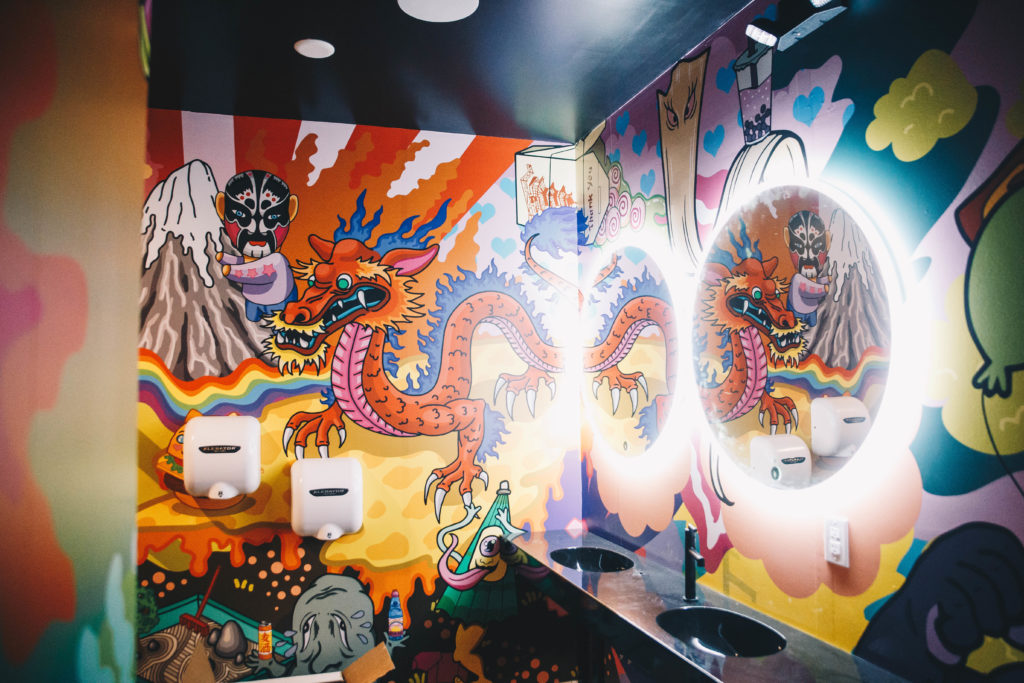Antihero Combines Fine Dining with Street Art to feature Detroit Artists
Antihero Combines Fine Dining with Street Art to feature Detroit Artists
Detroit is home to some of the most celebrated and talented street artists in the nation, and more businesses are finding themselves ‘inspired’ as a result. Instead of walking through the alleyways of Eastern Market or driving through Heidelberg Project, why not bring the street art inside, to enjoy along with a five-star meal and bottle of sake? That was the concept behind Detroit-based restaurant group Working Class Outlaws’ latest project, Antihero — a Japanese cuisine ‘izakaya’-style inspired restaurant.

Aside from enlisting award-winning chef Nick Erven for a heightened culinary experience, WCO aims to offer guests an equally exceptional visual stimuli and environment created by Detroit-based artists Glenn Barr, Shaina Kasztelan and Kadee Spangler.

To adorn the walls of the dining area, Antihero commissioned legendary Detroit artist, Glenn Barr to paint two large murals. The first, hovering over a trio of the restaurant’s minimalist booths, depicts an alleyway in Osaka, Japan that envelops the owners’ favorite watering hole, Jazz Bar Top Rank. The other sits above a sleek DJ booth near the entrance and melds a UFO, dragons and turntable all in front of a cityscape. Both futuristic murals are painted with muted colors to complement the warm decor of the interior. They blend reality with fantasy, transporting the viewer to a realm of unimagined possibilities.

In contrast to Barr’s darker pieces, WCO also commissioned tattoo artist Kadee Spangler and visual artist Shaina Kasztelan collaborate on vibrant, Candyland-inspired murals for the men’s and women’s bathrooms. Upon walking into the bathroom, guests are placed into a world of colorful whimsy. The walls are adorned with symbols of Japanese pop-culture, beyond internationally recognized icons like Hello Kitty. After recieving loose artistic direction and references from WCO, Kasztelan and Spangler were given complete creative control to bring their vision to life.

Spangler and Kasztelan knew each other from working with the restaurant group previously, and quickly became friends after seeing each other’s pieces in shows. Both of the artists employ the use bright colors and grotesquely cute imagery. “Kadee and I pretty much immediately agreed on this intense maximalist atmosphere that was reminiscent of the ultra colorful Decora fashion and all things kawaii (or “cute” in Japanese),” says Kasztelan. “It was great because Kadee had actually traveled to Tokyo a little while before this so she had a lot of insight of what she experienced there vs. what we know by researching on the internet.”

While the pair made sure to cover the walls with adorable kawaii imagery, Kasztelan says that they also made room for characters in Japanese folklore that wouldn’t necessarily be recognizable to most Americans. “We made sure to include some weird, supernatural imagery and represent some of the “underdogs” in Japanese culture that don’t get enough attention – I mean, it’s called Antihero after all,” says Kasztelan. “One of my favorite folklore references in the women’s restroom mural is a cartoon recreation of the skeleton in renowned Japanese artist Utagawa Kuniyoshi’s woodblock print “Souza No Furudairi” made in 1844. Legend has it that these spirits called Gashadokuro (“starving skeleton”) roam after midnight, grabbing lone travelers and biting off their heads to drink their spraying blood- super creepy but super badass.”

Kasztelan says this combination of dark and cute is a staple in her work that is rooted in a lifetime of dealing with depression, anxiety and bullying. “The juxtaposition of light/dark, cute/grotesque, and good/evil is almost always present in everything I create. As a kid, I always felt like an outcast and was bullied for being the queer, goth kid that had terrible acne and
The duality of Kasztelan’s work is shown in the Antihero murals and throughout her prolific art collection, which includes 3D art, multiple murals in businesses and building walls, and incredibly detailed paintings. Much of het work typically function as a critique of American Consumerism and its effect on our environment, lives and social status — but not many people would deduce all of this from the few minutes they spend in Antihero’s bathroom.

Whether guests are fiddling over the perfect angle for their mirror selfie in front of Kasztelan and Spangler’s murals or letting their gyoza get cold while ogling the depth of character choice and meaning, it’s undeniable that the murals are attractive to all kinds of viewers. “Many people just want to see beautiful looking things because that’s what they’ve been taught is “art” which, I mean, that’s fine!” says Kasztelan. “I don’t think art necessarily needs to have a deep meaning to be considered art and art is subjective anyway so who is to say what is art and what isn’t?” The murals are pieces of art that have just as much business being in a museum of modern art as they do an alleyway or restroom of a nice restaurant. And isn’t that kind of the point anyway?

When asked about the importance of where a mural is painted, Kasztelan concludes that, while location is something to consider, it’s not the only thing to consider. “I think location and context definitely frames how the public views the work in a way because that’s how normal society is taught to view art,” says Kasztelan. “BUT, I also think that art is art and will speak for itself. And not everyone who is a true, amazing artist gets the opportunity to exhibit their work in a gallery or get paid to do something for a business. Outsider art is real art too!”
VISIT ANTIHERO
231 W. Nine Mile, Ferndale, Michigan.
(248) 307-7383
HOURS
Sunday, Monday & Tuesday: 4pm to 11pm, kitchen open until 10pm
Wednesday & Thursday: 4pm to 12am, kitchen open until 11pm
Friday & Saturday: 4pm to 2am, kitchen open until 12am
*No reservations*
The post Antihero Combines Fine Dining with Street Art to feature Detroit Artists appeared first on PLAYGROUND DETROIT.
